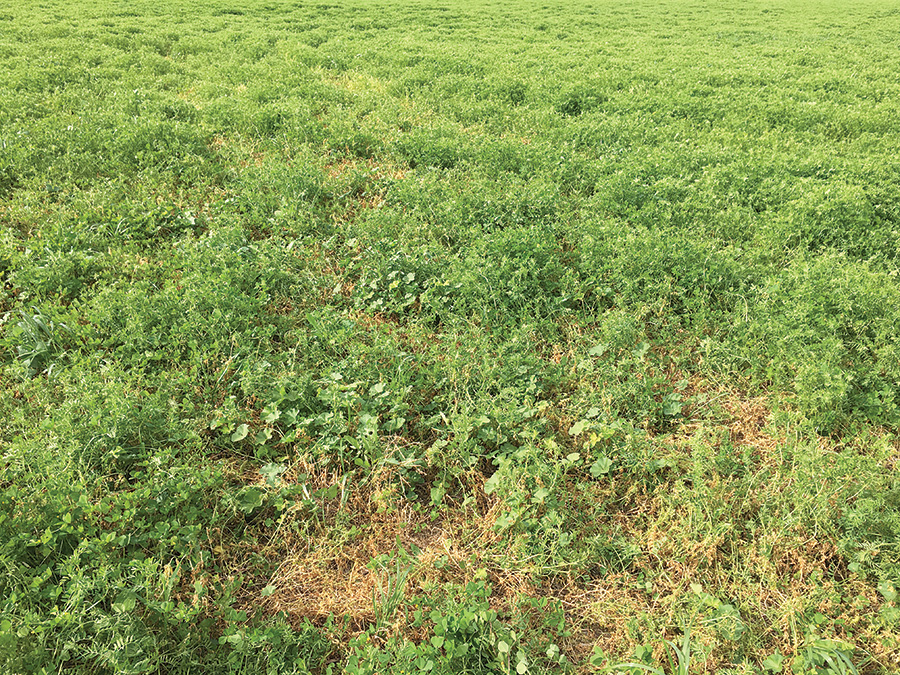Key points
- Failing to control Sclerotinia stem rot in pulse crops can allow disease inoculum to carry over to following canola crops
- Narrow-leafed lupins and chickpeas are highly susceptible to Sclerotinia. Lentils and vetch are less susceptible, and faba beans and field peas are the least susceptible of all pulse species
- Check high-risk pulse crops weekly, taking photos of symptoms to determine if disease lesions are increasing on plants and across paddocks
Plant pathologists have found that some pulse species are more susceptible than others to the damaging diseases Sclerotinia white mould and Sclerotinia stem rot.
The three species of the pathogen found in pulse crops are Sclerotinia sclerotiorum, S. minor and S. trifoliorum.
If the fungal pathogen is left uncontrolled in highly susceptible pulse crops, the carryover of inoculum can present a significant risk to canola and pulse crops in the rotation.
Sclerotinia’s hosts include canola, chickpeas, lentils, faba beans, lupins, vetch, field peas and pasture and broadleaf weeds. Wheat, barley and oats are not hosts.
Species susceptibility
NSW Department of Primary Industries and Regional Development senior plant pathologist Dr Kurt Lindbeck says narrow-leafed lupins and chickpeas are highly susceptible to the disease.
“Vetch and lentils have a medium level of susceptibility to Sclerotinia while faba beans and field peas are the least susceptible.”
He says the rise in popularity of the double break – where canola is grown after a pulse – means two Sclerotinia stem rot-susceptible species are grown in a row.
“From a disease management point of view, that is not ideal,” he says. “So, we are exploring how to grow pulses while reducing the Sclerotinia risk for canola.”
Dr Lindbeck says field experiments at Wagga Wagga have shown big differences between pulse species in terms of the amount of black survival structures (known as sclerotia) the pathogen produces.
“If one pulse species sheds fewer sclerotia into the soil, the risk to the following canola crop will likely be lower.”

Sclerotinia in vetch. Photo: Josh Fanning
Location risk
First, he says, consider whether Sclerotinia has been detected in your area. “If you are in an area that has never seen the disease, it is highly likely there are none or very few sclerotia in the soil.”
Second, he says, consider how often you grow broadleaf crops, which support the production and carryover of sclerotia. “If you don’t have a high intensity of broadleaf crops in your rotation, such as once every five years, and you aren’t seeing Sclerotinia symptoms, it’s less likely that Sclerotinia will be a big issue in your pulses and canola,” he says.
“If Sclerotinia was present in a disease-conducive year like 2022, you would have seen the disease in your crops.”
Disease surveys have been carried out in New South Wales, Victoria, South Australia and Queensland over the past two-and-half years with GRDC investment.
Victorian surveys
 Senior pathologist Dr Josh Fanning checks a lentil crop for Sclerotinia symptoms. Photo: Agriculture Victoria
Senior pathologist Dr Josh Fanning checks a lentil crop for Sclerotinia symptoms. Photo: Agriculture Victoria
Agriculture Victoria senior pathologist Dr Josh Fanning says 2022’s wet conditions facilitated disease expression across Victoria’s Wimmera and Mallee.
“We started receiving enquiries from growers about Sclerotinia in pulse crops in 2019,” he says. “The incidence of the disease has been gradually increasing as more growers have been including a higher percentage of pulses and canola in their rotations.”
Dr Fanning’s 2022 research showed that of 44 paddocks surveyed, 26 (59 per cent) showed visual symptoms of Sclerotinia. In 2023, no symptoms were detected in the paddocks surveyed because of the dry spring, but he says there were reports of the disease from growers and agronomists. He says the disease can be controlled with fungicides, depending on the growth stage. “If you see symptoms, note which paddock you see them because you will be able to monitor those areas more closely and reduce the risk with non-host crops in the rotation or foliar fungicides.
“A fungicide that has activity on Sclerotinia at canopy closure will reduce the disease severity and expected grain yield losses.”
South Australian surveys
 South Australian Research and Development Institute pulse pathologist Dr Mohsen Khani. Photo: SARDI
South Australian Research and Development Institute pulse pathologist Dr Mohsen Khani. Photo: SARDI
South Australian Research and Development Institute (SARDI) pulse pathologist Dr Mohsen Khani says 2022 was conducive for Sclerotinia because there was plenty of rainfall from July to October.
“A survey of six lentil paddocks across SA’s Yorke Peninsula and Upper and Mid-North showed there was a 90 per cent disease incidence in four of those paddocks,” he says.
“These paddocks were targeted based on information from growers and agronomists who had observed Sclerotinia symptoms.”
Dr Khani says Sclerotinia reduces grain quality, yield and harvesting ease because lentils affected by the disease lodge. He says there is also a huge risk in following broadleaf crops because the fungus can survive in sclerotia in the soil for up to eight years. In 2023, he says drier-than-average conditions from July to September in SA meant Sclerotinia lesions were uncommon in lentils.
“However, in five paddocks we surveyed, two to nine per cent of lentil plants had some level of the disease,” he says.
“One paddock sown at twice the recommended density had about 40 per cent of plants with Sclerotinia.” He says this highlights the impact of crop density on disease expression.
Variety susceptibility
A part of the research is exploring the susceptibility of different pulse varieties to Sclerotinia. While dry conditions meant there was no significant difference between varieties tested in 2023, the experiments are being repeated this year. Optimum sowing time, sowing density and fungicide management are also being examined to advise growers on best practices.

Lentil plants dying from Sclerotinia. Photo: Josh Fanning
Fungicide use
Dr Lindbeck says certain fungicides are registered to manage Sclerotinia on pulse crops, potentially reducing the production of inoculum to subsequent crops.
“Strategic use of foliar fungicides can significantly reduce inoculum production,” he says. “This means taking note of the in-season climatic conditions that drive the disease and being responsive to the risk.
“If the paddock has a history of developing the disease, ask yourself: ‘When am I going to plant the next broadleaf crop in the paddock, and what is the medium-term rainfall outlook?’”
He says research underway is investigating the optimal timing of foliar fungicides. “Future recommended application timings may vary between the different pulse crop species depending on growth stage susceptibility.
“As an example, with narrow-leafed lupins and Sclerotinia, as soon as you see symptoms, it is too late to control the disease.
“We don’t normally apply foliar fungicides to narrow-leafed lupins, but a treatment just before canopy closure will reduce disease development. Nonetheless, not every narrow-leafed lupin crop must be managed for Sclerotinia.”
Double breaks
Dr Lindbeck says growers who frequently see Sclerotinia on their pulse crops, particularly those who grow double-break crops (pulse/canola), should manage the disease in their pulse crops to reduce the risk to canola.
“Start thinking about managing Sclerotinia across the rotation. Even if you do not employ a double break, but grow lupins/wheat/canola, the sclerotia shed into the soil in lupins is likely to infect the canola whether that is two years or 12 months down the track.”
He says a decision-support tool is under development to assist growers with crop selection and management.
Dr Lindbeck says weekly monitoring of high-risk paddocks is crucial. “Nothing is more disheartening than walking into a crop and finding it full of disease. A strategic application of foliar fungicide when the crop is at a susceptible growth stage and the weather is favourable for disease development can save a lot of heartache,” he says.
More information: Kurt Lindbeck, kurt.lindbeck@dpi.nsw.gov.au; Josh Fanning, joshua.fanning@agriculture.vic.gov.au; Mohsen Khani, mohsen.khani@sa.gov.au

























































